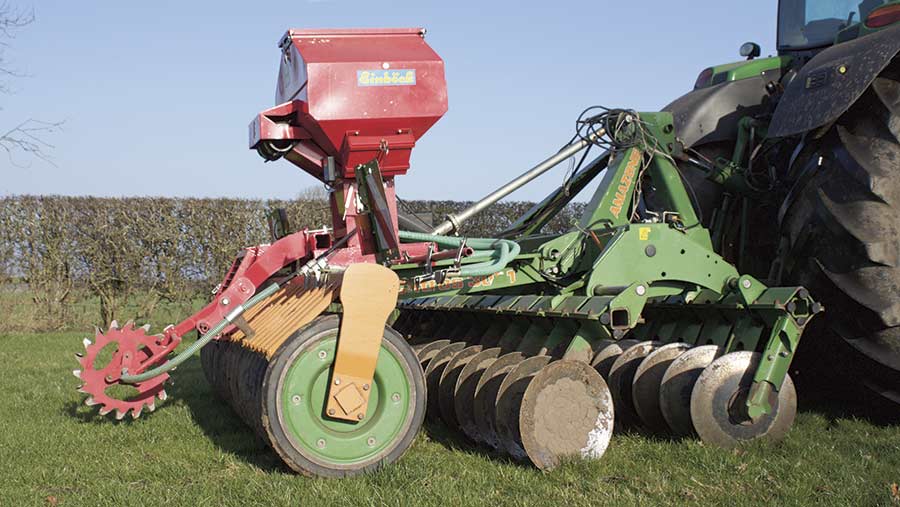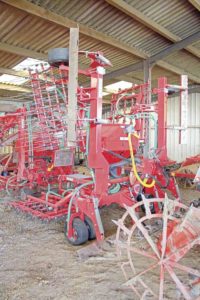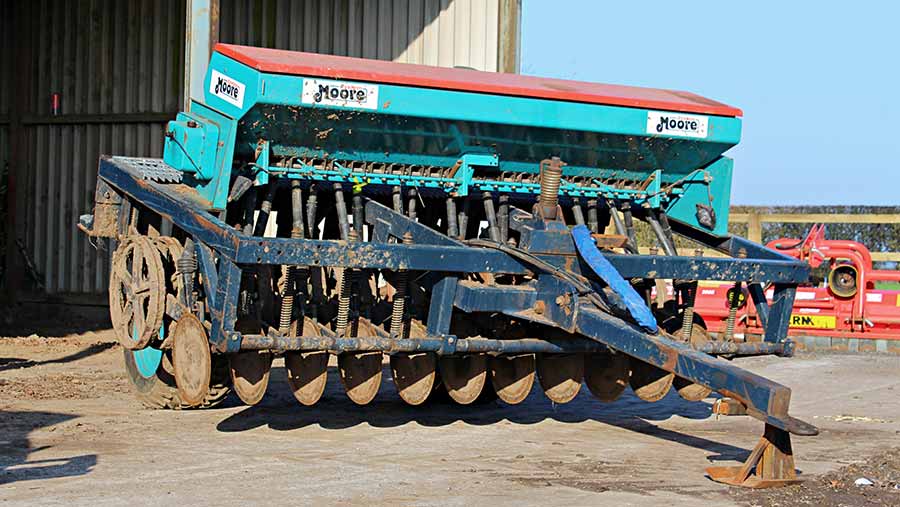Unusual mix of reseeding systems gives L&J Bennion the edge
Over the last couple of decades Middlewich contractor L&J Bennion has gradually honed its grassland reseeding and rejuvenating techniques to suit its customers’ requirements.
Now the team’s 1,000ha workload is split between full reseeds using a plough-based system, direct planting with a Moore Unidrill and working straight into stubbles with a home-made disc planter.
We got operations manager Simon Rutter to talk us through each system and explain where it fits in.
See also: How to sort out grassland compaction
1. Home-made Discbock

© James Andrews
What’s the system?
It’s a set of 3m Amazone Catros discs with an Einbock air seeder unit mounted on the top.
We built it in 2013 because we were getting increasing requests for a cheap method of establishing grass, cover crops and stubble turnips after cereals. At the time we nicknamed it the ‘Discbock’ and it seems to have stuck.
The build was pretty straightforward – we’d already got a set of 3m Amazone Catros discs that weren’t being used much, so we bought an Einbock Pneumaticbox seeder and grafted it on the top.
We were in such a rush that we managed to put it together in an evening.
First off, we welded a bracket on the rear packer to mount the seeder unit on.
Originally we planned to fix it on the mainframe, but we soon realised the metering wheel wouldn’t reach the ground and it wouldn’t follow the contours either.
The next task was to weld a bar – pulled out of an old milking parlour – on to the mounting frame to hold the eight seed outlets.
These were positioned so that they dribble the seed behind the two rows of discs and in front of the rear packer.
It works really well and you get a pretty even surface, particularly if you do a quick run over with the seeder out of gear first.
In fact it’s so good and cheap that every year we see a steady stream of people ditching full reseeds in favour of this.
The Catros discs also cope well with trash, even when there’s a large amount of chopped straw.
The fact that they have half-metre telescopic sections on the sides also means that you can run with a slight overlap to avoid ridging and still work to 3m.
It’ll happily thunder along at 15kph and because we don’t sow with an overwrap we’ll cover the ground almost as quickly as we do with our 6m Einbock seeder.
In total the build cost £12,200, including the £10,000 we paid for the discs and £2,200 for the Einbock kit. Interestingly, Amazone now has its own version called the GreenDrill.
Thankfully there’s very little to go wrong with it, but we have just replaced the discs, which set us back £370 for a set of 24.
It was only when the new ones arrived that we noticed how worn the old ones were – they were like tea saucers. Unsurprisingly it’s perked up its performance a bit.
Where do you use it?
We mainly use the Discbock for establishing grass leys directly into stubbles, but we’ve also gone direct into some roughish grass.
It won’t work if the ley is too old and tough though because you can’t generate enough tilth. It also gets used for planting cover crops and stubble turnips.
When we’re planting grass into stubbles we tend to use lightish seed rates of about 32kg/ha, but because there are eight outlets across 3m it tends to look pretty thick.
How many hectares?
In total we’ll plant about 300ha, and about 160ha of this will be planting grass into stubbles or ground coming out of spuds.
How much does it cost?
If we do a quick run through with the discs first it’ll cost about £70/ha.
2. Einbock Pneumaticstar Pro

© James Andrews
What’s the system?
Full reseeds still account for the lion’s share of our grassland work, even though we’re seeing a switch towards the cheaper one-pass disc system.
We start off by ploughing, usually in August or September, and then do a pass with the power harrow before running through with a set of Cambridge rolls with levelling paddles.
Often we’ll put in another pass with the power harrow before seeding with our 6m Einbock Pneumaticstar Pro.
With this we always sow with a double overlap to ensure we get a thick even result with no misses between bouts.
The Pro is a seriously impressive machine and you can happily cruise along with it at 15kph. The heavy-duty levelling boards also do a great job bashing any clods that are left on the surface.
We also have a lower-spec version that has a lighter construction and a battery-powered fan rather than the pto-powered one on the Pro version.
With this you’re limited to a drilling speed of about 10kph, so we tend to use the Pro for most work.
Where do you use it?
We use this system where people want to establish a top-quality, long-term ley and we’ll use seed-rates between 45 and 55kg/ha.
If you’re going to be keeping the ley for 10 years or so, it’s worth the investment to get it right and you’ll have a much smoother and more even finish.
How many hectares?
In an average year we’ll reseed about 620ha using this method, but it’s dropping about 10% each year as people move to the Discbock.
How much does it cost?
If you add it all up we’ll charge about £300/ha for a full reseed using this method, not including seed.
3. Moore Unidrill

© James Andrews
What’s the system?
The Moore Unidrill is the newest addition to our fleet and means we can offer a proper direct drilling service.
It’s a pretty straightforward system (as the name suggests) and the drill works as a one-pass machine.
Years ago we used to use an old 3m Bettinson drill, but because it had wheels on each end we got fed up with loading it on an off trailers.
The seed also came out so fast that we had to mix it with woodchip or sand to get the rate somewhere near right.
We traded it in for a Guttler Greenmaster, but we found this didn’t quite fit in with our system. In loose ground it bulldozed too much soil and tended to block up with straw when working on stubble – it’s a good machine, but just wasn’t right for us.
After spotting an advert for a 1994 Moore Unidrill in January 2016 – which turned out to belong to one of our mates – we ditched the Guttler and decided to give it a go.
Despite its age it had barely been used and had been kept covered up in a barn. We bought it for £6,000, which the sale of the Guttler covered easily.
We like the fact that there’s plenty of pressure on the disc coulters and we haven’t had any trouble getting it to cut in, even on bone-dry clay ground. Because it’s a box drill it’s also blissfully simple.
All we’ve had to do is replace a couple of the shim coulters because they’d worn out and were starting to block with soil.
As each set of discs is independently mounted they also follow the ground contours brilliantly and we’ve been comfortably drilling at 15kph.
Where do you use it?
We’ve mainly used it for going straight into old pastures that have been sprayed off, but we’ve also gone into some fields of patchy grass that needed perking up, too.
How many hectares?
We’ve been out of the direct-drilling game for a while now, so we only did 80ha with the Moore last year. Hopefully that will increase as people start to realise we’ve got it.
How much does it cost?
We charge £60/ha for direct drilling with the Moore.
Frontline machinery
L&J Bennion, Blue Slates Farm, Middlewich, Cheshire
Tractors: John Deere 6210R, 6175R, 6150Rx2, 7430, 6930 and 6630;
Massey Ferguson 6475; Ford 7840
Combine: Claas Lexion 530
Forager: Claas Jaguar 860
Drills: Two Einbock grass seeders; home-made Discbock; 3m Moore Unidrill; Kuhn Integra 3m box drill x 2; 6-row maize drill x 2; 8-row diamond maize drill
Cultivation kit: Kverneland ploughs x 4; Lemken ploughs x 2; Kuhn power harrow x 6; McConnel Shakaerator x 3; and 6 rotavators
Sprayer: Knight 24m trailed
Balers: McHale Fusion 3; Claas Markant 65 conventional balers x 2; New Holland BB940, BB9060 and BB950; Lely Welger D4000
Telehandler: JCB 531-70

